the Church in medieval England
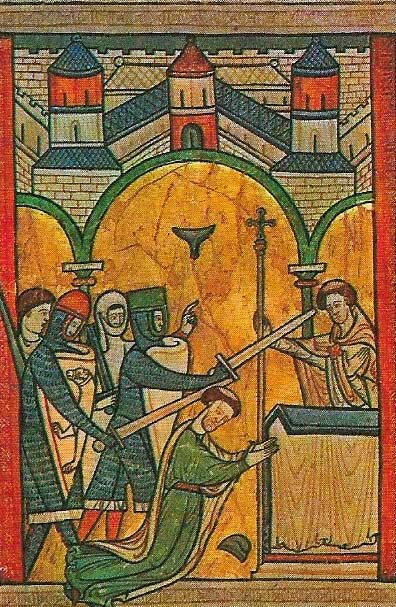
Figure 1. Thomas Becket (c. 1119–1170) was killed by followers of his former friend Henry II (r. 1154–1189). As Archbishop of Canterbury, he defied the king’s attempt to set up a centralised legal system that would cover members of the Church as well as the laity. Becket had served previously as chancellor to Henry; throughout the period the rulers of Church and state were often linked personally, even though their interests were kept carefully separated. Henry underwent many penances for the murder of Becket, who was canonized in 1173, and whose tomb in Canterbury Cathedral became the object of pilgrimages until the Reformation.

Figure 2. The friars came to England in the 1220s with the intention of revitalizing spiritual life by preaching and living in poverty. They were bound to no particular convent (although friaries were set up soon in many towns) and stressed pastoral work. Encouraged by Bishop Grosseteste, they were pioneers of philosophy and theology at Oxford University and included two of the finest medieval philosophers, Duns Scotus (c. 1264–1308) and William of Ockham (c. 1300–1347). They also transformed the art of preaching and used a vivid outspoken style to attract large congregations. They were prepared to attack injustice and defend the interests of the poor.
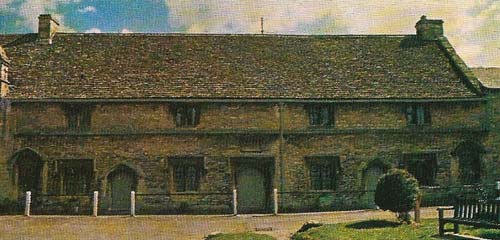
Figure 3. Almshouses, such as this one at Burford, Oxfordshire, became common in the 14th century, when the rural economy ceased to grow and urban poverty became a palpable problem. Charity had always been a charge upon both monasteries and bishops, and now hospitals, almshouses and religious fraternities were set up specifically to care for the victims of destitution and disease. The founders were often secular and ranged from the high nobility to permanent guilds of prominent townsmen.
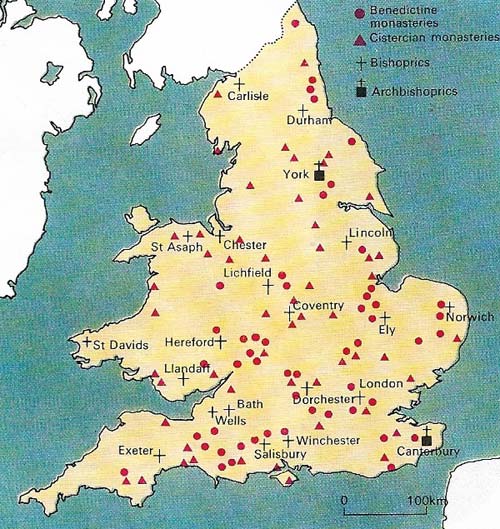
Figure 4. Monasteries were found in almost every part of England. These institutions, which were central to medieval Christianity, were often established as shrines and as centers for the dispensation of charity, as well as being landowning corporations. Each monastery was more or less independent of any superior authority, and the main problem of any prospective reformer such as Grossetestes was to battle with the abbots and cathedral chapters who were jealous of their privileges and local autonomy. As a result, much of the history of the English medieval Church is littered with obscure legalistic wrangles, with moral issues submerged. Benedictine monasteries were the oldest, dating from the Anglo-Saxons.
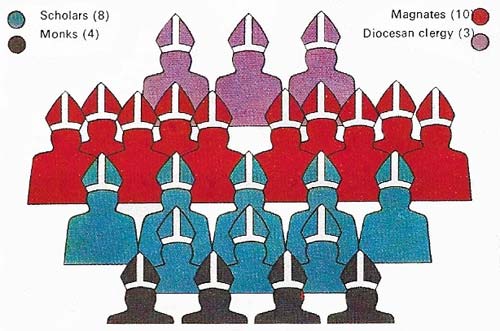
Figure 5. The episcopacy in England in 1275 comprised men from different backgrounds, but there was a higher preponderance of scholars and university-educated bishops than at any other time in the Middle Ages. During the next 50 years, the number of civil servants. Or royal administrators, sharply increased, reflecting a more secular outlook in the Church. At the same time, the rose on factionalism among the nobility made the Church – an important source of patronage and power – a more attractive object of baronial ambition, and many bishoprics came under the direct control of the barons. After 1350 encroachment of secular politics n those of the Church (as opposed to a secular attack on clerical privilege) was common.

Figure 6. Henry III (r. 1216–1272) organized the rebuilding of Westminster Abbey. Church-building was an important activity in the Middle Ages, uniting all classes in a common endeavour. The results of this building program are still obvious. The great church building began after the Norman Conquest and continued into the 13th century. Most of the 'decorated' or 'perpendicular" churches of the later Middle Ages were altercations of additions to older buildings. Local guilds or landowners often bore the building and maintenance costs.
The medieval English Church, like the Church elsewhere in Europe, had little spiritual or organizational unity, but was a tangled association of virtually independent bodies. It included monasteries and cathedral chapters, bishops and their officials and individual clergy, great international orders such as the friars, all catering more or less directly to the spiritual welfare of the country, and all under the general jurisdiction of a distant pope. It was a tinder-box of conflicting rights and privileges, careerism and spirituality.
Shrines and monasteries
To the layman in the Middle Ages the Church was a collection of shrines such as Canterbury, which had relics of St Dunstan and St Thomas Becket (Figure 1), Bury, with the body of St Edmund, and St Paul's, London, where the image of St Wilgeflot ("St Uncumber") was invoked by women who were tired of their husbands. Powerful monasteries (Figure 4) or cathedral churches grew up round these shrines, served by clerks or monks jealous of their privileges and profiting from the pilgrimages made to them.
Church authorities respected these popular cults but also attempted to impose order upon them and to raise the spiritual quality and education of the clergy. The first attempt, in the 10th century, was monastic. By 1200 the older monasteries were no longer the powerhouses of spiritual renewal, but they remained the most distinctive and often the best-loved of English religious institutions. Although varying greatly in size, they all shared a strong vested interest in their landed rights and, as a result, kept a weather-eye on political affairs. They had a slow, agrarian pace of life, and a conservative dislike of religious enthusiasm and novelty. In the 12th century, many austere houses including those of the Premonstratensians, Carthusians and especially Cistercian orders were founded to regenerate spiritual life.
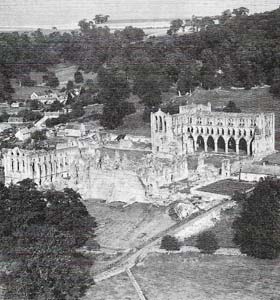 |
| Rievaulx Abbey was a Cistercian monastery founded on 1131. These monasteries were set far from civilization to encourage austerity, but they grew rich on the profits of wool production, which financed their great building programs. In later Middle Ages the Cistercians had become the principal butt of anticlerical propaganda aimed at the monasteries; they were seen as an overtly political and wealth-seeking organization, whose original Puritanism had become entirely lost. |
At first the monasteries maintained their corporate discipline. The monk's day began before dawn, and was devoted primarily to prayer, with labour in the fields taking up the rest of the time. According to the chronicler William of Malmesbury (c. 1095–c. 1143), monks abstained from meat, ate only one meal a day in winter, never wore fur or linen garments, and were sparing in speech. The abbot observed the same austere customs as his monks, although he dined separately from them, "with the strangers and the poor". In the later Middle Ages many orders of monks acquired a reputation for avarice, and although monks were rarely guilty of the debauchery portrayed by Protestant and anticlerical propaganda, comfort gradually replaced austerity after 1200.
 |
Tithe-barns, such as this in Tisbury, Wiltshire, were built to receive the tithes or taxes payable to the Church, comprising ten per cent of each parishioner’s gross earnings. Lawyers insisted that the poor, like the rich, had to pay tithes, but they added that priests were bound in charity to reprieve the very poor. At tithe-gathering, the village haywards used to ring the church bells and then go from house to house; but tithes were hard to enforce, and excommunications for non-payment were common. It was generally assumed that everyone owed a debt to the Church for protecting their spiritual interests, but not to be spent on worldly ostentation. |
The bishops and reform
The second attempt to organize the Church for pastoral work was episcopal. It began in the late 11th century in the atmosphere of reform engendered by Pope Gregory VII (reigned 1073–1085). Archbishop Lanfranc (c. 1005–1089) of Canterbury and his successor St Anselm (1033–1109) set up a regular organization of the English dioceses, and by 1150 the forms of diocesan organization, were clearly established. The beginnings of the canon law of the Church made possible stricter control of the various offices.
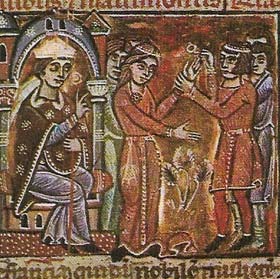 |
Sacraments such as marriage brought the Church to the center of the life of many people. The priest was often the only available doctor, marital advisor, teacher and lawyer for the village poor. |
A spate of parish church building between 1100 and 1250 (Figure 6) provided most communities with at least the rudiments of religion, and in the early 13th century the first attempt was made to regulate the religious life of the laity. Stephen Langton, Archbishop of Canterbury (1207–1228) and Robert Grosseteste (c. 1175–1253), Bishop of Lincoln (1235–1253), proclaimed that the laity should take common and private confession at least once a year.
An ambitious and wide-ranging attempt to provide an educated clergy was necessary: the ignorance of many parish priests was an evil often bewailed by Grosseteste. The new universities at Oxford and Cambridge became, under Grosseteste's influence, the breeding ground of a small group of highly educated churchmen (Figure 2). These men naturally came to occupy the commanding heights of the Church; by 1400 nearly all the bishops had attended a university and many parish priests, too, were educated there. The stream of educated graduates came to occupy posts of responsibility in the state as well as the Church and throughout the Middle Ages high promotion in the Church often depended upon previous service to the Crown (Figure 5), and vice versa. As a result, the question of who had ultimate authority to appoint the higher officers of the Church, whether it was the king or pope, was a major source of contention, as was secular infringement on clerical jurisdictions.
Wycliffe and Lollardy
Many of the graduate clergy, as well as laymen, were uneasy about ecclesiastical wealth. The most determined of the later movements of reform was the work of the fiery Oxford theologian and royal clerk John Wycliffe (c. 1328–1384). Wycliffe saw the organized Church as a creation of Antichrist and proposed a return to "simple" Christianity, free of both hierarchy and superstition, dependent on the Bible, and led by the Crown. His followers, known as the "Lolards", attracted much influential support, and their translation of the Bible (c. 1388), although officially condemned, was widely read. Their attack on established traditions, however, eventually brought down on them all the force of the Church.
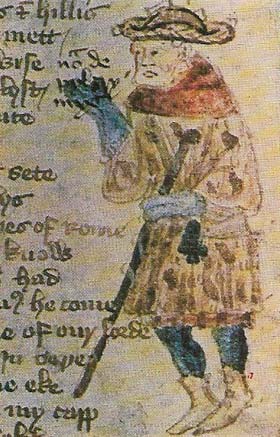 |
| This image of a “greedy friar” occurs in an early manuscript of the poem Piers Plowman (1370–1386). There were many attacks on the Church for its corruption for many parish priests were badly educated. |
